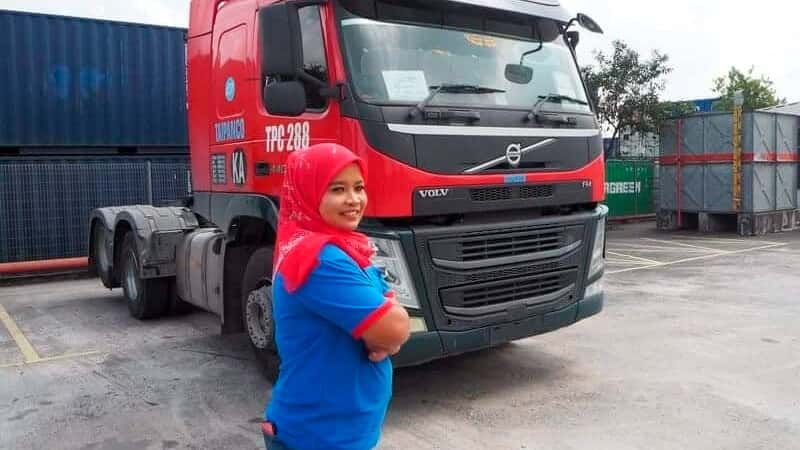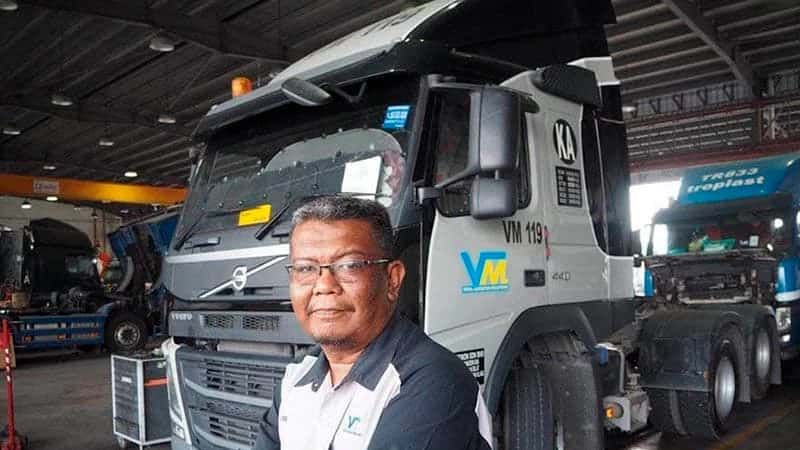Practice makes Truckers Perfect

In-house or external: training truck drivers is a crucial part of running a successful transport operation. Some truckers may claim that they have years of experience and may not need regular updates, however, they could not be more wrong. Truckers need to get updated on technology changes and skills need to be honed and that is what Volvo offers through their driver training programme. The need for regular training of truck drivers has long been recognised. Contributing to safety on the road and improved profitability, Volvo Trucks offers help from an in-house trainer.
The Mentor
Passionately known as “Rosdi”, Ahmad Rosdi, has been a mechanic and driver before becoming a driver trainer with Volvo Trucks. Having serviced and repaired cars in his own workshop, he learned the ropes of the automotive industry. A stint in a palm oil plantation, managing all transports in an estate was followed by the move to become a truck driver. Joining a container haulier, he sat for his license and afterwards joining a renown oil and gas transporter.
His proudest achievement was being appointed as the driver mentor, when he was working with Shell. He was the youngest mentor at the age of 30. “As you can imagine, that was not easy as I was about ten years younger than most drivers and they would not take advice from me as they thought I was lacking experience.” Today, older drivers still challenge him.
Having joined Volvo Trucks in 2009, he now conducts about 150 to 200 sessions in a year, training about 1 000 drivers. The shortest sessions would be two hours, in which case he prefers to do a 100 percent practical session as he knows that truckers want to learn hands-on. If time permits, he recommends full day trainings that are split in half between theory and practice. Train the Trainers (TtT) for transporters takes a minimum of two days and can be extended to four days. Out of the 1 000 drivers, only two or three drivers are females while some 60 percent are between the ages of 30 to 50 with the oldest driver clocking in at 73 years old.
Training requirements are either given by the customer or prescribed following an assessment. “The oil and gas industry for example requires a driver assessment before we can administer training.” Rosdi relies heavily on the format of the Volvo Fuelwatch driver assessment approach to train drivers as the program was highly effective to change behaviour and instil new skills.
“The main issues we need to address are attitude and knowledge in our training sessions.” In his view, defensive driving is an aspect that should be taught more, but acknowledges that it is difficult. Drivers should be assessed often and training should be done on a one-to-one basis, which imposes on the operation.
When asked what is the most important aspect of knowledge to be included in a training program, Rosdi cites specifications of the truck. “It is the foundation to know the capabilities of your vehicle. Only then can you be a good driver as you will know what your truck is capable of.”Specifications impact acceleration and breaking, which in turn will impact the way the vehicle needs to be driven. Lack of knowledge may also impact the attitude of the driver. Not knowing the capabilities of the truck may stifle their effort to be good drivers. For instance, brake technology has changed and nowadays, exhaust brakes can operate without limitations, whereas older versions could only work for a maximum of 20 minutes.
It may come as a surprise that the biggest impact of driver training that he observed was the reduced wear and tear of brakes, followed by fuel consumption being the second. The use of brakes actually has a heavy impact on cost. With reduced brake wear and tear, downtime is reduced, while the way a truck is decelerated also impacts fuel consumption and tyre wear.
During training, all sorts of things can happen. Older drivers may come with the attitude that they know everything, having driven trucks for decades and after all, it is all the same: brake, steering wheel and the trailer in the back. “It sometimes is a wake-up call when they then have to operate the vehicle and cannot find the parking brake despite having all the experience.” Rosdi recalls how a training that was supposed to be one day only ended up to for three days in Sarawak as the program had to be translated into Chinese, Malay and Iban.
Naturally, Rosdi also needs to be trained on new models and techniques. He has two trainers that he can call upon, one in Australia and one in Sweden. “Both are called Per. So they are P1 (Per Dahl) and P2 (Per Bruun Hansen)”. Some training modules are as long as two weeks, whereby training modules for specialist industry segment, such as mining are part of the curriculum.
Maybe the one skill that cannot learn from his sifus is “Patience”, which in Rosdi’s view is the most important to have as a drive trainer..

The Rookie
Norafaliza binti Roslan is 32 years old and has only recently made the transition from working at toll gates for nine years to being a full time, fully licenced container haulage driver. For eight months she has now been with Shallas Sdn Bhd and is blossoming in her new profession. The transition was just a question of time as she has always wanted to be a truck driver, but was under the impression that this profession was solely for guys.
After riding along with colleagues to absorb the daily routines and basics of driving truck, she sat for her licence in a driving school. Eventually, she was given her own truck to manage along with training on the job and she is now moving containers.
Having gotten her feet wet in the past eight months, she now feels it is high time to learn more and to become a better driver through targeted training. “Besides how to drive a truck, I want to know the function of every component and part of the truck. By knowing all this, I will better understand how a truck works and in case of a breakdown, I can troubleshoot first to see if I can solve the problem before calling it in.” She hopes that she will be able to attend training at least twice per year.
“My bosses support this ambition. My biggest issue at the moment is the ability to monitor my surroundings and paying attention all the time. When driving a large vehicle, one has to be much more aware of what is going on: cars around the truck, road conditions and obstacles.” While she is expecting to be treated and trained equally to her male colleagues, she hopes that females are being given more training on the intricacies of the technology. “Generally, boys are more interested in technology and they already know all that there is about how engines and gearboxes work when they enter the workforce. Also, there should be more teaching in school on how trucks work.”

The Veteran
Bringing with him 17 years of experience as a trucker is Azrul haiza bin Abdul Aziz 45, who joined Vertex Mission Sdn Bhd in 2003 after being driver and manager in a Felda plantation, overseeing all aspects of the production. His career-shift was motivated by the desire to have a better living. However, it turns out that the main attraction now is the job satisfaction that comes with being a full time trucker. “I like the flexibility!”
When it comes to training, Azrul has undergone countless sessions in his career. Preferring practical training, he opines that drives should at least have four half-day sessions per year in order to maintain their skills and to upgrade their knowledge. Refreshers are crucial in his view as drivers may forget certain aspects of safe and fuel efficient driving. The training he is really hoping to see more in the curriculums is defensive driving skills.
The ultimate test, of course, is the Volvo Fuelwatch competition. During the training for the competition, Azrul learned a lot: how to manage the truck, driving behaviour and awareness. The Fuelwatch, in his view, was a good tool as there was an assessment of the driver. “I feel that this is very important. Drivers should be re-assessed on a regular basis and the training need to be repetitive as we tend to forget a lot of things.”
He suggests that driver behaviour should be linked to incentives so that training is not seen as a burden, but a way to motivate drivers better to perform at their best. Having undergone a lot of training, he sees that the method of teaching over time has not changed much. The difference may be in the amount of theoretical training administered, which could be higher for certain sectors and also the evolution of truck features over time. He recalls having handled oil and gas products and classroom training to educate drivers had been extensive.
The ultimate test, of course, is the Volvo Fuelwatch competition. During the training for the competition, Azrul learned a lot: how to manage the truck, driving behaviour and awareness. The Fuelwatch, in his view, was a good tool as there was an assessment of the driver. “I feel that this is very important. Drivers should be re-assessed on a regular basis and the training need to be repetitive as we tend to forget a lot of things.”
He suggests that driver behaviour should be linked to incentives so that training is not seen as a burden, but a way to motivate drivers better to perform at their best. Having undergone a lot of training, he sees that the method of teaching over time has not changed much. The difference may be in the amount of theoretical training administered, which could be higher for certain sectors and also the evolution of truck features over time. He recalls having handled oil and gas products and classroom training to educate drivers had been extensive.